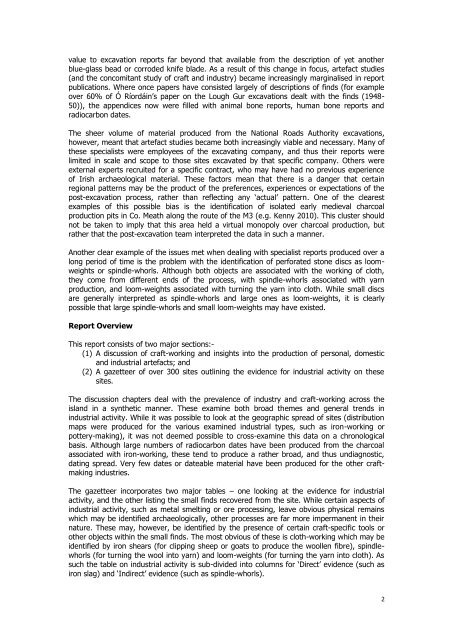EMAP_2012_Report_6_1.pdf (7.3 MB) - The Heritage Council
EMAP_2012_Report_6_1.pdf (7.3 MB) - The Heritage Council
EMAP_2012_Report_6_1.pdf (7.3 MB) - The Heritage Council
Create successful ePaper yourself
Turn your PDF publications into a flip-book with our unique Google optimized e-Paper software.
value to excavation reports far beyond that available from the description of yet another<br />
blue-glass bead or corroded knife blade. As a result of this change in focus, artefact studies<br />
(and the concomitant study of craft and industry) became increasingly marginalised in report<br />
publications. Where once papers have consisted largely of descriptions of finds (for example<br />
over 60% of Ó Ríordáin’s paper on the Lough Gur excavations dealt with the finds (1948-<br />
50)), the appendices now were filled with animal bone reports, human bone reports and<br />
radiocarbon dates.<br />
<strong>The</strong> sheer volume of material produced from the National Roads Authority excavations,<br />
however, meant that artefact studies became both increasingly viable and necessary. Many of<br />
these specialists were employees of the excavating company, and thus their reports were<br />
limited in scale and scope to those sites excavated by that specific company. Others were<br />
external experts recruited for a specific contract, who may have had no previous experience<br />
of Irish archaeological material. <strong>The</strong>se factors mean that there is a danger that certain<br />
regional patterns may be the product of the preferences, experiences or expectations of the<br />
post-excavation process, rather than reflecting any ‘actual’ pattern. One of the clearest<br />
examples of this possible bias is the identification of isolated early medieval charcoal<br />
production pits in Co. Meath along the route of the M3 (e.g. Kenny 2010). This cluster should<br />
not be taken to imply that this area held a virtual monopoly over charcoal production, but<br />
rather that the post-excavation team interpreted the data in such a manner.<br />
Another clear example of the issues met when dealing with specialist reports produced over a<br />
long period of time is the problem with the identification of perforated stone discs as loomweights<br />
or spindle-whorls. Although both objects are associated with the working of cloth,<br />
they come from different ends of the process, with spindle-whorls associated with yarn<br />
production, and loom-weights associated with turning the yarn into cloth. While small discs<br />
are generally interpreted as spindle-whorls and large ones as loom-weights, it is clearly<br />
possible that large spindle-whorls and small loom-weights may have existed.<br />
<strong>Report</strong> Overview<br />
This report consists of two major sections:-<br />
(1) A discussion of craft-working and insights into the production of personal, domestic<br />
and industrial artefacts; and<br />
(2) A gazetteer of over 300 sites outlining the evidence for industrial activity on these<br />
sites.<br />
<strong>The</strong> discussion chapters deal with the prevalence of industry and craft-working across the<br />
island in a synthetic manner. <strong>The</strong>se examine both broad themes and general trends in<br />
industrial activity. While it was possible to look at the geographic spread of sites (distribution<br />
maps were produced for the various examined industrial types, such as iron-working or<br />
pottery-making), it was not deemed possible to cross-examine this data on a chronological<br />
basis. Although large numbers of radiocarbon dates have been produced from the charcoal<br />
associated with iron-working, these tend to produce a rather broad, and thus undiagnostic,<br />
dating spread. Very few dates or dateable material have been produced for the other craftmaking<br />
industries.<br />
<strong>The</strong> gazetteer incorporates two major tables – one looking at the evidence for industrial<br />
activity, and the other listing the small finds recovered from the site. While certain aspects of<br />
industrial activity, such as metal smelting or ore processing, leave obvious physical remains<br />
which may be identified archaeologically, other processes are far more impermanent in their<br />
nature. <strong>The</strong>se may, however, be identified by the presence of certain craft-specific tools or<br />
other objects within the small finds. <strong>The</strong> most obvious of these is cloth-working which may be<br />
identified by iron shears (for clipping sheep or goats to produce the woollen fibre), spindlewhorls<br />
(for turning the wool into yarn) and loom-weights (for turning the yarn into cloth). As<br />
such the table on industrial activity is sub-divided into columns for ‘Direct’ evidence (such as<br />
iron slag) and ‘Indirect’ evidence (such as spindle-whorls).<br />
2
















